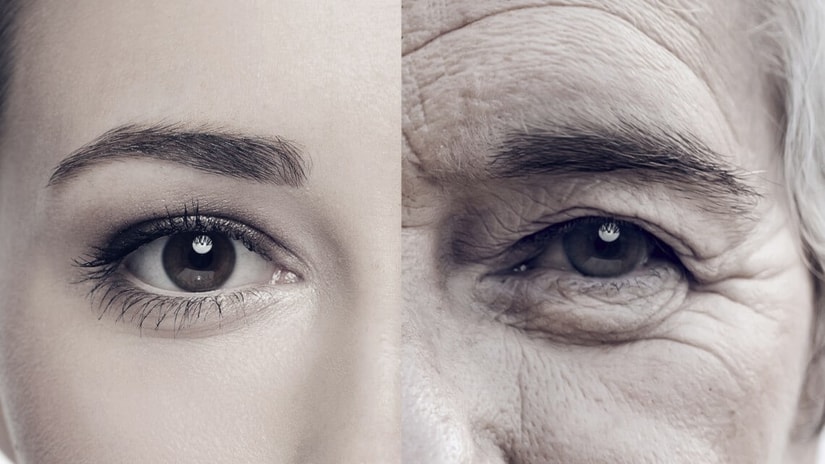The people proposing aging theories remind me somewhat of the story of the seven blind men examining an elephant: to the one feeling a leg, an elephant is like a tree; the one feeling the trunk thought he was like a big snake, etc.; each being correct so far as he went. So it with the aging theories, each is probably correct to a certain extent. – Denham Harman
During the last few decades, life expectancy in developed countries has become longer. This fact can be explained by the progress in medicine and better life standards. At the same time, there has been a dramatic increase of cardiovascular disorders, obesity, diabetes, osteoporosis, and cancer, which are considered to be associated with the aging process. Aging itself is compared with a sort of a disease. Medical care can extend the life span, but it does not enhance the internal health and cannot stop the aging process.
Aging depends on many factors. If we understand what makes us old we can find the ways to defend ourselves. Numerous scientific studies have been implemented since 19th century to explain why we age. Modern theories of aging break down into two major categories: the preprogramed and the damage theories.
Preprogramed Theories
Discoveries in the area of the cell structure and its life limit made the basis for the preprogramed theories. According to the recent findings, all aging changes have a cellular basis. Partially, these changes are determined by genes. A cell has a nucleus, which hosts DNA – a genetic program that includes all information about an individual. With genes we get a program of aging.
DNA also sets a fixed number of cell replications.
Human bodies are built up of different types of cells: mitotic (dividing), postmitotic, and resting. Leonard Hayflick, Professor of Anatomy of the University of California, discovered that the capacity of replication of mitotic cells is limited. After a cell reproduced itself a certain number of times, it dies. Every division bears a threat of alteration; the older the cell, the more alterations it has undergone. Then the moment comes when the cell blueprint is so changed, that the cell cannot replicate itself properly anymore. Other types of cells either have very limited ability to divide, or cannot reproduce themselves at all. When nerve, kidney, or heart muscle cells are lost they are not replaced. You may learn more about Dr. Hayflick’s researches by reading the Handbook of the Biology of Aging and How and Why We Age .

However, not only genes affect the aging process. Approximately 40 percent of a cell aging depends on the life style of an individual. The damage theories explain aging from this perspective and are consistent in many things with the perceptions of ancients about a quality of energy and life rate.
Damage Theories
The damage theories describe many other factors that affect aging. First of all, free radicals, a product of metabolism, destroy cells and cause aging on a cellular level. The metabolic rate, another factor, shows how fast you consume your energy and how fast you age. Like in a mosaic every factor is important to create the complete picture about reasons of aging.
The Metabolic Rate Theory
The metabolic rate theory explains how we accelerate aging by spending our energies in vain. Metabolic rate is defined as calories burned per gram of body mass per day. We burn our energies when we grow, repair from illnesses, digest food, exercise, work, or become stressed. The problem is that the reserve of energy each of us has got is not unlimited. All living beings use up a fixed amount of energy during their lifetime. When the reserve is depleted, the system shuts down.
It follows that each living species has a fixed maximum life span. Some scientists believe for humans it is 1380 months (115 years), for a Chimpanzee – 534 months, for a dog – 408 months, and for a mouse – 42. Other scientific calculations tell that an approximate maximum life span of humans is 125 years.
Recall the recent energy blackout in North America. Everyone understood, that if the energy supply is limited, it has to be consumed rationally. It is true for other resources as well: the faster you consume your limited reserves of water, food, or cash the sooner you run out of them. Countries with limited reserves of natural oil and gas try to conserve these resources and buy from importers.
Apply this rule to yourself: the faster you consume your energy potential, the sooner you wear out and age. It occurs when our contaminated bodies spend more time on digestion of “dead” food, when we consume more food than needed, when we exercise too much or get exposed to air and water pollutants. We also age faster when we infect our minds with negative thoughts and our souls with negative emotions. Does this theory correlate with the teachings of ancients?
If you learn how to preserve your energy you can delay aging. One of the attempts to limit consumption of energies is a caloric restriction therapy. There is also plenty of other methods of energy conservation and extension of the life span.
Energy Restriction
In the western world, the caloric restriction therapy became known with the description of the regimen of a Venetian nobleman Luigi Cornaro (1464-1565) in his book Discourse on the Sober Life . His illness at the age of forty forced him to adopt a strict lifestyle of sobriety from eating and wine drinking.
Luigi has not only recovered from the illness, but also has lived a long and productive healthy life.
The experiments of Clive McCay in 1935 showed that when caloric intake was kept to about 30-40 percent of what was normally eaten, the metabolic rate slowed down and the aging process was delayed. This translated into a decreased number of diseases and increased survival rate in the experimental groups. Roy Walford, M.D., of University of California at Los Angeles, a leading authority in the caloric restriction therapy, conducted countless experiments on animals and even on himself during last two decades. His experiments showed that when a calorie-restricted, but a nutrient-rich diet was maintained the life span increased, the blood cholesterol and blood sugar both decreased, physical activity, intellectual skills, and appearance were preserved youthful. To learn more about the Roy Walford’s caloric restriction therapy, select books from the following list: Beyond the 120-year Diet: How to Double Your Vital Years (2000), The Anti-Aging Plan (1995), The Anti-Ageing Plan: Strategies and Recipes for Extending Your Healthy Years (1994), The 120-Year Diet (1988).
However, caloric restriction is not the only way to balance metabolism of the body. For example, yoga exercises assist stretching you joints, muscles, and spine, balancing the energies and metabolism as well. You may consume fewer calories naturally when you rid wastes of your intestine and let your blood absorb more nutrients. If you are sufficiently fed with nutrients, you do not feel food cravings. Fasting is the way to detoxify your body and save energy for natural healing and restoration of functions.
When you are dieting under a caloric restriction plan distinguish the different types of fats. Dr. Robert Atkins in his book Dr. Atkins’ Age-Defying Diet Revolution emphasized the fact that the biochemistry of the fats we consume makes all the difference. He also said that since margarine was introduced in the United States as a low-fat substitute of butter, the number of cardiovascular diseases skyrocketed in the country. Some fats are so essential for the health of your cells, that elimination of them from the diet can cause irreversible changes. Ayurvedic healers would probably add that Vata type people may benefit from taking more fats during cold times, and that the diet of every person should be individualized.
If we get back to the cell replication process, we recall that when a cell divides properly, a full biological regeneration occurs. However, the regeneration is disturbed when free radicals attack a cell and cause cellular mutations. Energy restrictions plans help in many ways to neutralize the damage of free radicals, but some other therapies are needed as well to influence the longevity of a cell.
Free Radicals
The free radicals theory was originated by Dr. Denham Harman of the University of Nebraska, and currently is considered a prevailing theory of aging. You can imagine the affect of free radicals as rusting or oxidation. For example, a piece of an apple gets brown when exposed to oxygen.
During our lives we undergo the process of natural oxidation as we breathe. The oxidation is accelerated when the metabolic rate increases, when we are exposed to adverse external conditions like smog, environmental pollution, radiation, cigarette smoke, and stress. We can suffer up to 10,000 free radical attacks every day.
A free radical is an unstable, highly reactive atom with at least one unpaired electron. To balance itself, the free radical steals an electron from another atom thus giving birth to a new free radical and originating a chain of destructive reactions. Cell membranes are especially vulnerable to the aggression of free radicals. When the nucleus is damaged, the cell loses it ability to replicate itself. The cell may be harmed so seriously that this condition can lead to cancer and mutation of chromosomes. The impaired cell replication results in the weakened immune system, memory loss, skin aging, and many age related disorders.
Free radicals damage a connective tissue, which consists primarily of collagen. This is where the free radicals theory and the cross-linkage theory may come together to explain the loss of elasticity of connective tissue. When collagen is affected by free radicals, cross-links are formed to tie the collagen threads to each other. As a result the connective tissue becomes less and less elastic. Morning stiffness is one of the symptoms of this process. You may find more details in the book Secrets of Life Extension by John A Mann.
The books Increasing Healthy Life Span: Conventional Measures and Slowing Innate Aging Process (2003) and Towards Prolongation of the Healthy Life Span: Practical Approaches to Intervention (Annals of the New York Academy of Sciences) (1998) by Denham Harman will tell you more about the free radicals theory and about the role of antioxidants in anti-aging therapies.
Antioxidants
Antioxidants deactivate free radicals and prevent ruinous effects of oxidation on a cellular level. Antioxidants are certain vitamins, minerals, and enzymes that improve survival under conditions of exposure to toxins by inhibiting mutations of a cell.
The most effective antioxidants are: beta-carotene, vitamin C, vitamin E, selenium, riboflavin, zinc, copper, and manganese. A diet rich in these vitamins and minerals will defend you effectively against the aggression of free radicals. Blueberries, strawberries, raspberries, grapes, citrus fruits, red wine, tomatoes, seafood, sweet potatoes, carrots, and other products will provide your body with an abundance of natural antioxidants.
Consuming synthetic supplements will not have the same effect. When antioxidants are supplemented the cells may decrease on manufacture of their own intrinsic antioxidants. Recent studies also show that taking some synthetic supplements can even be dangerous for your health. Read more in the following books: Every Person’s Guide to Antioxidants by John R. Smythies, Antioxidative Stabilization of Polymers by Iu. A. Shliapnikov (1996).
Sources:
Fountain of Youth by the Editors of Ronin Publishing, California, U.S.A. (1996), Asian Longevity Secrets by Ping Wu, M.D. and Taichi Tzu, Ph.D., U.S.A. (2003), “Life Extension for the 21st century: The views of Professor Roy Walford of UCLA”, www.walford.com, La nouvelle ?ternit? bien vivre 120 ans by Gabriel Simonoff, France (1993), Dr. Atkins’ Age-Defying Diet Revolution by Robert C. Atkins, M.D. New York, NY, U.S.A. (2000).


